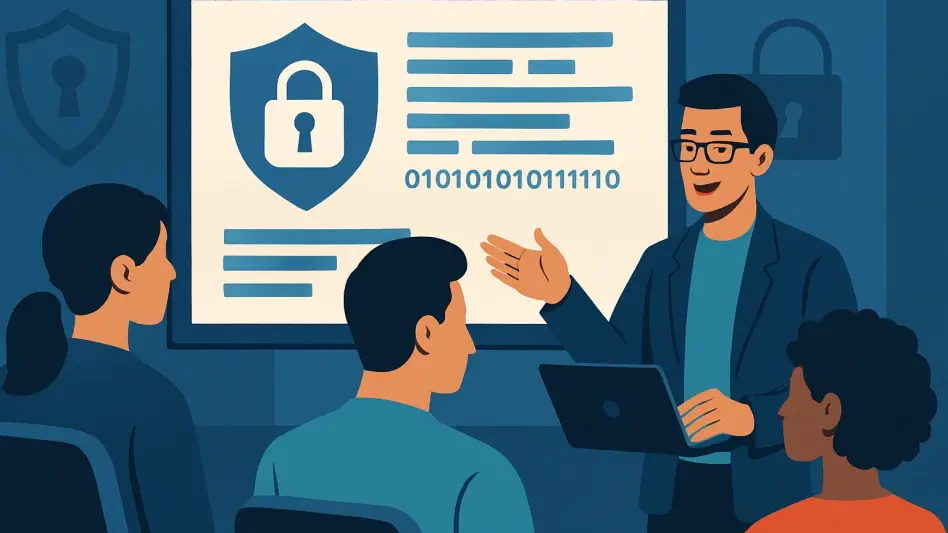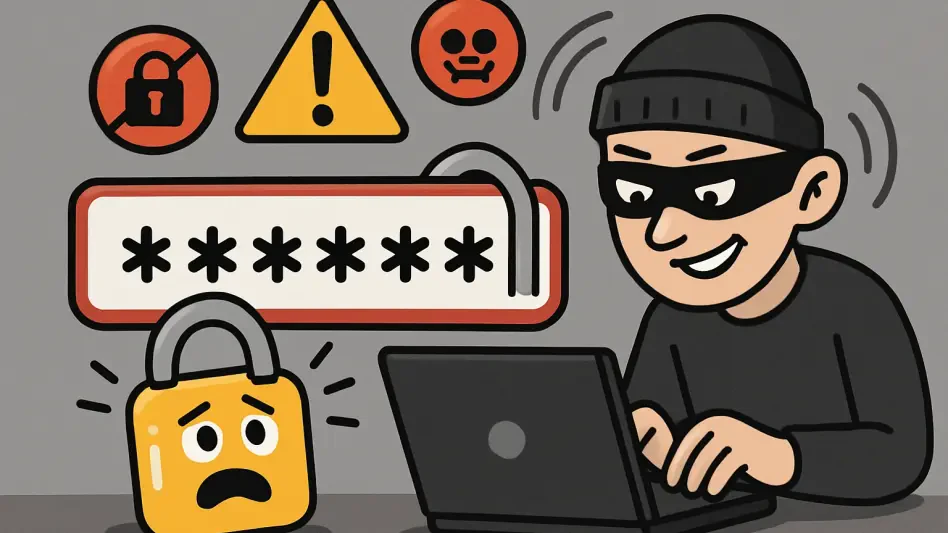In an era where digital threats loom larger than ever, the startling reality is that even the most advanced technological defenses can be undermined by a single human mistake, highlighting the urgent need for comprehensive training. Recent findings from a 2024 report on cybersecurity leadership reveal that the majority of chief information security officers identify human error as the foremost risk to organizational safety in the digital realm. This underscores a critical need for robust training initiatives that transform employees from potential weak links into vigilant protectors against cyber threats. While firewalls and encryption are vital, they alone cannot safeguard a company if staff members unknowingly click on malicious links or fall prey to phishing scams. A comprehensive cybersecurity awareness program is essential to bridge this gap, equipping teams with the knowledge and skills to recognize and respond to dangers. However, crafting such a program is no small feat—it demands a strategic blend of education, engagement, and continuous improvement rather than sporadic efforts or one-off sessions. This article delves into the key steps to design and implement an effective training framework that empowers employees to stay ahead of evolving risks, ensuring a fortified defense against the ever-growing landscape of cybercrime.
1. Understanding the Critical Need for Team Education
Cyberattacks strike with alarming frequency, occurring every 39 seconds according to research from the University of Maryland, while the volume of incidents targeting organizations rises by 25% each year. The financial toll is staggering, with the average cost of a data breach now reaching $4.9 million, marking a 10% increase from previous records. Projections from the International Monetary Fund further highlight the global scale of this issue, estimating that cybercrime could cost the world $23 trillion within the next 24 months—a 175% surge over recent years. These statistics paint a clear picture: cyber threats are not only more frequent but also more devastating, making employee training an urgent priority. Educating staff on identifying and mitigating risks is no longer optional but a fundamental component of any security strategy. Without this focus, companies remain vulnerable to attacks that exploit human oversight, regardless of technological safeguards in place.
Beyond the raw numbers, several underlying factors emphasize the importance of cybersecurity education. Human error often serves as the entry point for breaches, whether through accidental data exposure or succumbing to sophisticated phishing schemes. Meanwhile, cybercriminals continuously refine their tactics, operating in coordinated groups that target specific weaknesses. Additionally, regulatory mandates in sectors like finance and healthcare—such as GDPR, HIPAA, and PCI-DSS—require consistent training to ensure compliance. Failing to address these areas can result in legal penalties alongside reputational damage. A well-informed workforce acts as a proactive barrier, reducing the likelihood of successful attacks and ensuring adherence to industry standards. Building awareness is thus a multifaceted necessity that protects both data and organizational integrity.
2. Assessing and Evaluating the Existing Security State
Before launching a cybersecurity awareness initiative, a thorough evaluation of the current security environment within an organization is crucial. This initial step establishes a baseline to measure progress and pinpoint areas requiring immediate attention. Key questions to address include whether employees grasp fundamental concepts like phishing detection or the use of multi-factor authentication (MFA). It’s also vital to determine if a formal incident response plan exists and if staff members know the appropriate actions to take during a suspected breach. Additionally, assessing compliance with existing security policies—such as reporting suspicious activity—helps identify gaps in adherence. This comprehensive review lays the groundwork for a tailored program that addresses specific vulnerabilities while aligning with broader organizational goals.
To gather actionable insights, various methods can be employed to gauge the level of cybersecurity awareness among employees. Surveys and questionnaires offer a direct way to assess knowledge of threats and protocols, revealing common misconceptions or training needs. Simulated cyberattacks, such as phishing exercises, provide practical feedback on how staff respond to real-world scenarios, highlighting strengths and weaknesses in their defenses. Conducting one-on-one Q&A sessions or interviews with employees and IT personnel further uncovers perceptions and daily practices related to security. These approaches collectively paint a detailed picture of the organization’s cybersecurity culture, enabling leaders to prioritize critical areas for improvement and craft a program that resonates with actual workforce capabilities and challenges.
3. Establishing Clear Aims and Targets for Training Initiatives
With a solid understanding of the current security posture, the next step involves defining precise, measurable objectives for the cybersecurity awareness program. Setting clear goals ensures that efforts are focused and progress can be tracked over time. Examples of such targets might include achieving 100% employee participation in training sessions, with mandatory skill refreshers every 90 to 120 days. Another aim could be reducing the use of unsecured devices, like unpatched mobile phones or USB drives, by 50% within a year. Additionally, scheduling quarterly educational meetings with customers and partners to discuss emerging threats fosters a collaborative approach to security. These objectives provide a roadmap, guiding the program toward meaningful outcomes while maintaining momentum through smaller, achievable milestones.
Tailoring these goals to the specific needs of the organization enhances their relevance and impact. For businesses handling sensitive customer data, a primary focus might be improving encryption practices and raising awareness of data governance standards. In contrast, companies in regulated industries such as healthcare or finance may prioritize compliance training on frameworks like GDPR or HIPAA, ensuring all staff complete relevant modules within set intervals. Customizing objectives based on industry demands or internal vulnerabilities ensures that the program addresses the most pressing risks. This strategic alignment not only maximizes the effectiveness of training efforts but also reinforces a culture of accountability and preparedness across all levels of the organization.
4. Developing a Comprehensive Training and Education Plan
Once goals are set, constructing a detailed and engaging curriculum becomes the foundation of a successful cybersecurity awareness program. This involves working backward from overarching objectives to create monthly and weekly milestones that guide progress. The training content should be accessible, informative, and supportive, encouraging employees to stay committed. Offering diverse formats caters to varied learning preferences—online courses can cover topics like network security and ransomware, while live webinars with experts delve into current threats and solutions. Simulated attack scenarios, such as mock phishing exercises, provide hands-on experience, and interactive workshops enable direct engagement through activities and questions. This variety ensures that all staff members can absorb critical information in a way that suits their learning style.
Continuous learning is equally vital, as cyber threats evolve rapidly, demanding regular updates to keep skills sharp. Scheduling training refreshers every 90 to 120 days helps maintain relevance in the face of new risks. Monthly check-ins, through quizzes, newsletters, or quick tips, reinforce key concepts and keep security top of mind. Offering advanced training and certification opportunities beyond basic modules encourages deeper expertise, while recognizing “security champions” in different departments fosters advocacy for best practices. These champions can inspire peers and highlight the importance of adherence to protocols. By embedding ongoing education into the organizational fabric, the program remains dynamic, adapting to emerging challenges and sustaining a proactive stance against cyber threats.
5. Involving and Motivating the Workforce
Designing a robust training plan is only half the battle; engaging employees to actively participate is equally critical for success. Cybersecurity education must be practical and relevant, connecting directly to daily tasks and job roles to demonstrate its value. Gamification offers an effective way to boost interest, incorporating rewards or recognition for completing quizzes or identifying threats like phishing attempts. Such game-like elements make learning enjoyable and encourage consistent involvement. When employees see training as a meaningful part of their routine rather than a chore, they are more likely to internalize lessons and apply them in real situations, strengthening the overall security posture.
Further enhancing engagement involves grounding training in real-world contexts and fostering collaboration. Using examples based on actual cyber incidents—whether from within the organization or industry peers—helps staff understand the tangible consequences of their actions. This approach illustrates how individual choices impact security outcomes, making lessons more impactful. Additionally, promoting peer-to-peer learning encourages employees across departments to share experiences, tips, and insights during training exercises. This collaborative environment not only builds camaraderie but also makes the process feel more approachable and less daunting. By prioritizing relevance and interaction, the program cultivates a sense of shared responsibility for safeguarding organizational assets.
6. Monitoring, Assessing, and Refining the Approach
A cybersecurity awareness program cannot remain static; it must evolve through regular evaluation and adaptation to remain effective. Tracking key metrics provides insight into the initiative’s impact—simulation results can reveal how many employees successfully counter mock attacks and what strategies proved effective. Monitoring incident response times and the speed of reporting suspicious activity highlights readiness, while completion rates for training modules and workshops indicate participation levels. Gathering employee feedback through surveys and interviews also uncovers perceptions of the program’s strengths and areas for growth. These data points collectively inform whether the training meets its objectives or requires adjustments to better address gaps.
Continuous refinement based on these assessments ensures the program stays aligned with emerging threats and organizational needs. If simulations show recurring vulnerabilities, such as difficulty identifying phishing emails, targeted modules can be introduced to address this weakness. Similarly, feedback suggesting overly complex content might prompt simplification or alternative delivery methods. Adapting to new cyber trends, like ransomware tactics, keeps training current and relevant. This iterative process not only enhances the program’s effectiveness but also demonstrates a commitment to improvement, encouraging employees to stay engaged. By prioritizing analysis and flexibility, the initiative evolves into a resilient tool that consistently bolsters defenses against digital risks.
7. Fostering a Lasting Culture of Cybersecurity Awareness
Reflecting on the journey of building a cybersecurity awareness program, it became evident that sustained effort was key to embedding a security-first mindset. Continuous training and regular updates proved essential in keeping pace with the dynamic nature of cyber threats. Leadership played a pivotal role by modeling best practices and creating an environment where staff felt safe to report issues without fear of repercussions. Empowering employees with actionable knowledge and tools significantly lowered the risk of incidents, while also enhancing the ability to respond swiftly when challenges arose. These combined efforts transformed awareness from a mere checklist item into a core organizational value.
Looking ahead, the focus should shift to actionable next steps that build on this foundation. Regularly revisiting and updating training content to reflect the latest threat intelligence ensures relevance. Encouraging open dialogue about security concerns can further strengthen trust and vigilance across teams. Investing in advanced tools or partnerships that support ongoing education will also provide a competitive edge in combating cyber risks. Ultimately, the goal remains to nurture a program that employees not only engage with but also champion, driving a culture of proactive defense. By committing to these strategies, organizations can better safeguard their digital landscapes against future uncertainties.








